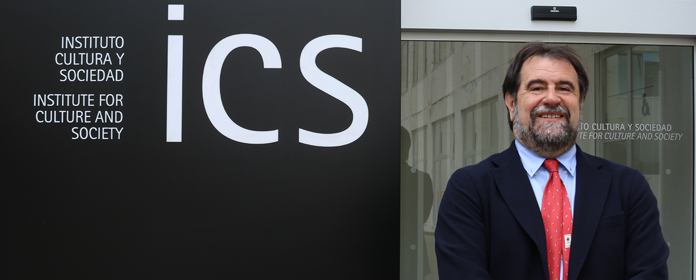"In a museum, the pieces must be able to speak," says the former director of the Spanish National Archaeological Museum
Miguel Ángel Elvira, Professor of Art at the Complutense University of Madrid, participated in the Rethinking Cultural Heritage seminar at the Institute for Culture and Society

FOTO: Elena Beltrán
Museums celebrate their international day on May 18 with the organization of events that revolve around a theme— this year’s theme is “Hyper-connected Museums.” In a society where everything is connected, museums join the trend through videos, interactive panels, and live performances with the aim of creating a more didactic and entertaining environment that helps reinvigorate the value of cultural heritage, bringing it closer to the public.
Experts who work with two important museums in Spain, the National Archaeological Museum (MAN for its initials in Spanish) and the Lázaro Galdiano Museum, spoke recently about the identity and challenges of these institutions at the Institute for Culture and Society of the University of Navarra. They participated in the Rethinking Cultural Heritage seminar organized by the Creativity and Cultural Heritage project.
Art Professor Miguel Ángel Elvira, who directed the MAN from 2000 to 2004, participated as a speaker. The MAN is the most frequented national museum of the last five years with more than half a million people passing through it per year.
In relation to this year’s theme, Professor Elvira is in favor of including technological advances, but "not with a mere click that takes the visitor to a fixed image with text.” Rather, he prefers something more interactive that adds value. For example, he mentioned a MAN video about the origin of Greek mythology that he thinks "fabulously" explains a complicated topic.
The Complutense University professor claims that museums work differently depending on their genre, which affects the versatility of how they exhibit their collections.
He recognizes that an archaeological museum has a "tremendously expensive" display that is "difficult to change.” It works "with a showcase and impressive security" such that every change must be well thought out because it can take many years to change. On the other hand, in his opinion, a museum that houses paintings can change its exhibition easily and relocate canvases so that the viewer experience is less complicated.
However, he notes that archaeological museums have the advantage of hosting recreations. Miguel Ángel Elvira recalls that, in his time as the MAN director, the center hosted storytellers and artists who gave ceramics classes. At one point, a Roman legion fought against the Arevaci in the courtyard of the building.
All these initiatives go hand in hand with another challenge— avoiding excessively long explanations. "The pieces must be able to speak,” he emphasized. Thus, "a 30-page history lesson [in each room] is unnecessary." In the end, he proposes choosing the main pieces to highlight and accompanying each of them with "five explanatory lines."
The professor does not give advice on how to visit a museum, although he recommends that the public "approach them to see the story they want to share, nothing more.” He believes museum attendance involves going with "freedom of criteria" and enjoying all the peculiarities of a complex museum, which reflects reality itself.
The MAN: A reflection of the Spanish momentThe MAN is precisely that— a complex museum, like reality itself. Miguel Ángel Elvira says that it is a mirror of Spain at the moment. "What Spain means (country, nation, as a whole) is complicated, which the museum reflects," he explains.
He admits that the MAN has had problems of definition since its inception. In the beginning, it housed pieces that were not destined to the Prado, or were obtained from expropriations. Otherswere from the Museum of Natural Sciences, such as Egyptian sculptures, and from the National Library “we took everything that was not books, like coins." But what meaning was assigned to this collection?
The main conflict is whether the Archaeological Museum is a "museum of Spanish archeology or a museum in Spain that collects pieces from all over." He, as its director, was in favor of the latter option. He maintains that otherwise the "Greeks, Etruscans and Byzantines" are left out, which are very interesting for history. At present, the MAN houses non-Spanish artifacts on its last floor.
"It's a magnificent museum. But it is difficult to tell the history of Spain without including, for example, Portugal,” the professor explains. However, other more distant areas such as the Canary Islands are included.
The difficulty with the MAN, from Elvira’s point of view, is that it has serious political problems of a conceptual nature, which reflects the reality of Spain's problems.
On the other hand, the museum faces another stumbling block in what is meant by archeology. The current idea of the discipline "does not resemble what those who launched the MAN had in mind." For them, archeology is about ancient or old art, "objects that elucidate when it comes to studying history." In this description, things like coins or pieces of churches fit. The current concept, on the other hand, is "a science dedicated to excavation and interpretation of found objects." In this conception, there are pieces that, within the current perspective, do not seem to fit in an archeological museum.
Some propose changing the museum’s name in order to better justify its contents. However, the expert is not in favor of this because he believes that any title that is given to the institution will pose the same problems. "One does not ask why the Louvre has that name or if it should be changed; with the MAN, the same principle applies."
